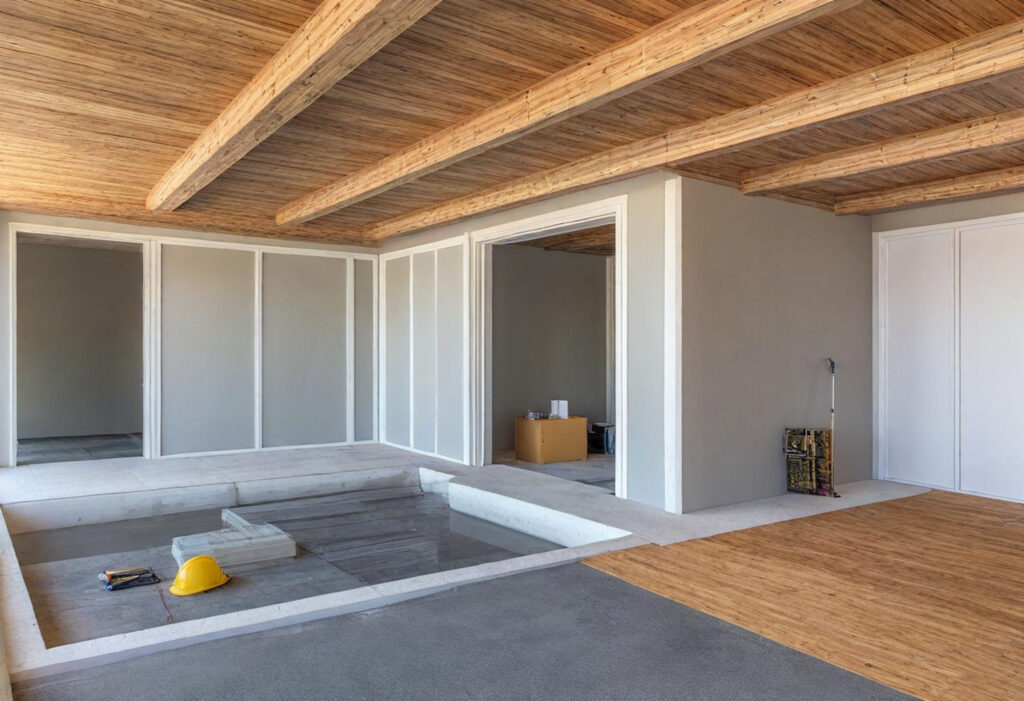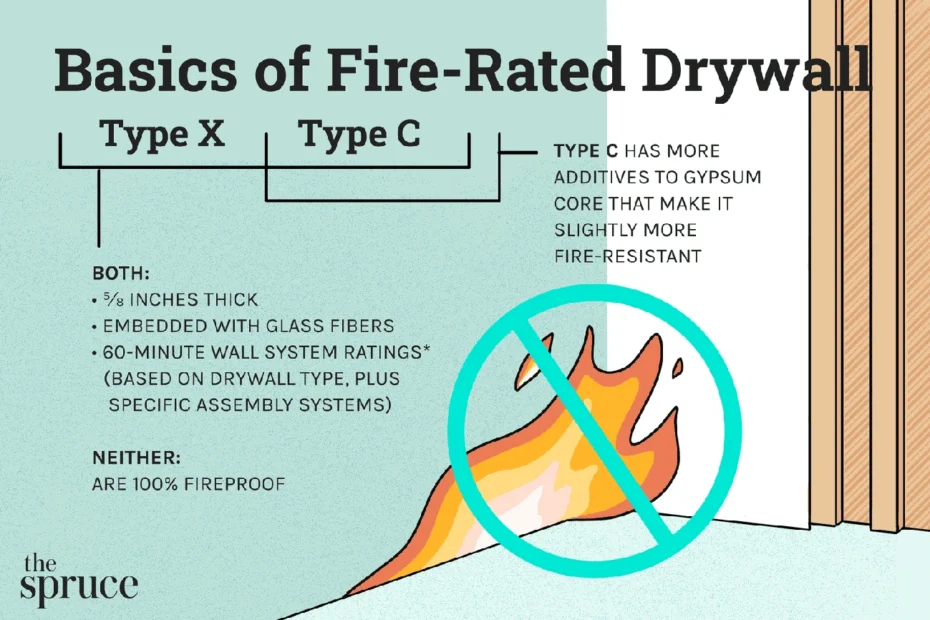The UK’s most devastating structural fire in nearly two decades struck Grenfell Tower in 2017. This tragedy serves as a stark reminder that fire safety protects lives and property. No homeowner can risk overlooking these precautions, particularly in vulnerable spaces like basements.
Fire-resistant materials serve a vital role in protecting our homes. They slow down flame spread and reduce smoke levels effectively. These protective elements make the difference between minor damage and total loss when builders use them in fire-resistant construction. The fireproofing market will reach USD 2.5 billion by 2032. This growth shows that fireproofing has become essential to modern home construction.
Let me show you the most effective fire-resistant materials for houses. My focus will be on basement applications where fire hazards often go unnoticed. You’ll learn everything needed to make your below-ground areas safer through proper fireproofing techniques. This knowledge applies whether you plan a new project or renovate an existing space.
Understanding Fireproofing in Basements
Fireproofing your basement goes beyond meeting building codes. Your home’s safety depends on protecting one of its most vulnerable areas. Let’s look at why basement fireproofing needs special attention.
What is fireproofing in construction?
Fireproofing uses materials that stop or slow down fire spread. This gives people time to evacuate and reduces damage to the building. Many people think some materials are completely fireproof – they’re not. Materials are fire-resistant and protect structures for specific periods.
Construction fireproofing materials come in two types:
- Passive protection: Fire-resistant coatings and insulating materials that slow fire spread
- Active protection: Systems like sprinklers and alarms that respond directly to fire incidents
Fireproofing disrupts the fire triangle—heat, fuel, and oxygen. It insulates fuel sources, produces oxygen-diluting gases, or triggers chemical reactions that stop ignition. Building codes specify hourly ratings from one to four hours based on how the building is built and used.
Why basements are high-risk zones
Basements create unique challenges because they’re underground, lack natural airflow, and have limited access. On top of that, they house utilities like boilers and electrical systems that could start fires.
Fire safety experts call basement fires the most dangerous type in homes. The enclosed design creates fires with limited ventilation that can spread to upper floors without anyone noticing.
Basements need better structural fire resistance. A two-story house with a basement needs 30 minutes of fire resistance. This increases to 60 minutes for buildings with four or more stories.
Common fire hazards in below-ground spaces
Your basement faces several fire risks:
Mechanical systems pose major dangers. Faulty furnaces, water heaters, and gas-powered equipment can cause fires, especially when they’re poorly maintained or surrounded by items that catch fire easily.
There’s another reason to be careful – electrical hazards. These include old panels, wrong extension cord use, and overloaded circuits. Watch out for buzzing outlets or frequent power outages.
Poor storage habits make things worse. Flammable liquids, old newspapers, cardboard boxes, and other items that burn easily create serious fire hazards. Even dryer vent lint causes about 15,500 fires every year.
You can make your basement safer through proper fireproofing once you spot these hazards.
Top 8 Fire-Resistant Materials for DIY Basement Projects

Choosing the right fire-resistant materials is a vital step to creating a safer basement environment. These eight options provide different levels of protection against fire spread. They help contain flames and give people more time to escape during emergencies.
1. Fire-rated gypsum board
Fire-rated gypsum board, also known as Type X or Type C drywall, has special additives in its core to resist fire. Type C cores deliver additional fire resistance ratings in tested systems. The gypsum core doesn’t support combustion or transmit temperatures above 212°F until it’s completely calcined—a slow process that provides valuable time. Products like Gold Bond XP Fire-Shield C feature a specially treated, fire-resistant core and can achieve UL fire ratings.
2. Concrete and cementitious backer board
Concrete stands out as one of the most fire-resistant materials because it doesn’t ignite. It has a slow heat transfer rate and acts as a thick barrier against flames. Cement board, which combines cement, water, and reinforcing fibers, achieves a Class A fire rating. This makes it perfect for basement walls and ceilings that need enhanced fire safety.
3. Intumescent paint and coatings
Intumescent coatings expand under high heat and create an insulating layer that protects underlying structures. This chemical reaction creates a protective char that limits heat transfer and gives people more time to escape. These coatings come in water-based, solvent-based, or epoxy-based formulations that combine aesthetic appeal with structural protection.
4. Fire-resistant insulation (mineral wool, fiberglass)
Mineral wool insulation can handle temperatures above 1,000°C and doesn’t combust. It produces minimal toxic smoke during fires. Fiberglass insulation withstands temperatures up to 220°F, though kraft paper-faced batts can catch fire. Both materials reduce sound while providing fire protection.
5. Fire-rated doors and frames
Fire-rated doors and frames are essential to contain fire and limit smoke spread. Ratings range from 20 minutes to 3 hours. Hollow metal doors are the only option accessible to more people with a 3-hour label. Fire-rated doors need self-closing mechanisms and positive latching to maintain their protection level.
6. Fire-resistant caulks and sealants
Fire-resistant sealants block the spread of fire, smoke, and gases through penetrations and joints. These specialized products create strong barriers that stay intact during fires. When properly applied around utility penetrations, these sealants protect for up to four hours.
7. Fire-rated glass blocks or windows
Fire-rated glass blocks protect while letting natural light through. They come in various designs and achieve ratings from 45 to 120 minutes based on thickness and construction. These blocks pass rigorous UL testing to meet fire safety standards.
8. Treated fire-resistant wood
Fire-retardant-treated wood uses pressure impregnation with special chemicals instead of surface coating. This treatment slows combustion by forming a protective char layer. Available as lumber or plywood, these products meet building code requirements with flame spread ratings of 25 or less.
How to Choose the Right Materials for Your Basement

Smart basement fireproofing decisions call for a practical approach based on your specific needs. Here’s a guide to help you pick materials that will best protect your space.
Assessing your basement’s layout and use
Your basement’s purpose shapes your fireproofing needs. The space might serve as a living area, storage room, or utility area. Basements with utilities like boilers and electrical systems have heightened ignition risks. Your escape routes need careful planning. Livable basement spaces must have safe exits through the main staircase, an extra stair with another way out, or properly designed escape windows.
Matching materials to fire rating needs
Your home’s structure determines the fire rating requirements. Two-story houses with basements typically need 30 minutes of fire resistance. Buildings with four or more stories require 60 minutes. ICF (Insulated Concrete Form) basements must have a 15-minute fire barrier for any exposed EPS (expanded polystyrene).
Balancing cost, performance, and ease of installation
These factors matter when picking materials:
- Location: Check fire risk areas like utility spaces
- Project scope: Complete renovations let you install integrated systems like concrete or masonry
- Budget constraints: Fire-rated drywall provides economical protection compared to specialized systems
- Installation complexity: Materials like gypsum board work well for DIY projects with proper tools
- Environmental impact: Long-term sustainability goes hand in hand with fire protection properties
Note that no material is completely fireproof—even heavy timber can be fire-resistant while still being combustible. So, focus on systems that slow fire spread to give you significant evacuation time.
Installation Tips for DIY Fireproofing Success
The way you install fire-resistant materials makes all the difference. Let me walk you through the significant steps that lead to DIY success.
Preparing surfaces and measuring correctly
A tape measure helps you accurately measure wall studs to the nearest quarter-inch. Your basement needs inspection to check existing insulation or fire-stopping measures. The precise location where studs intersect with floor joists matters a lot in placing fire blocking correctly.
Using the right tools and safety gear
Fireproofing projects demand safety above everything else. The equipment you need includes:
- Protective gear to apply fireproofing materials
- Measuring tape, pencil, and paper to create a layout
- Fire-rated spray foam to seal gaps
- Materials to create fire blocks (wood planks, OSB, or 5/8″ drywall)
Avoiding common mistakes during installation
Gaps between fireproofing materials create a major problem. Small openings let flames and smoke spread quickly. The standard fifteen-minute protection extends with fireproof coating application. Fire-rated foam should seal all penetrations that accommodate wiring and plumbing.
When to call a professional
Code requirements or complex applications with bond testing need professional expertise. Fire ratings and material compatibility in construction fireproofing need specialized knowledge.
Conclusion
Basement fireproofing is a vital safety investment for your home. Fire hazards in basements need specific attention, and certain materials can reduce these risks by a lot. Type X drywall, mineral wool insulation, and intumescent coatings create a complete protection system that works better than individual solutions.
Safety should come before looks or convenience when you choose fireproofing materials. You need to understand your basement’s specific needs and fire rating requirements before starting any project. It also matters how well you install these materials – the difference between proper protection and dangerous gaps in your safety system depends on it.
Note that no material can completely fireproof your space. These materials give you extra time during emergencies that could save lives and protect your property from severe damage. Without doubt, your original investment in quality fire-resistant materials gives you better safety and peace of mind.
DIY enthusiasts can handle many basement fireproofing projects. However, knowing when to call experts shows good judgment. You should get professional help for complex installations or if you’re unsure about building codes. Fireproofing is both practical and a serious duty to protect your family’s safety and your home.
A fireproofed basement improves safety and lets you rest easy knowing you’ve taken real steps against one of homeownership’s biggest threats. This piece equips you to build a safer living space from the ground up.
